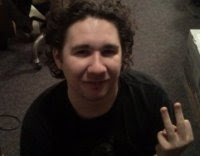"And they never did have any children after that."
- Hottentots
The Steampunk Trilogy falls over three novellas. In the first, Victoria, a mad scientist has replaced the actual Queen Victoria with a rather lifelike and deceptive clone made from the DNA of a Hellbender Newt, which they use while the real Victoria has disappeared to god knows where. Cosmo Cowperthwait, the mad scientist and protagonist of the story, must find a way to maintain the clone while tracking down the real Victoria, matching wits with an evil silver-nosed nobleman (the nose is purported to cause swoons in women), and his large associate, who exudes such an air of danger that our hero carries around a .50 caliber shell inside a gun-cane for the sole purpose of ending him. This is a great little novelette, with mystery and suspense abound as Cowperthwait and his Texan manservant Nails McGroaty track Victoria through the underbelly of Victorian society in the hopes that they can restore the monarch before the clone gives herself away by eating more bugs in public or something like that. It sets the tone quite well with the freaky lab of Cowperthwait and the one man satire of Americans that is Nails McGroaty. While at times it gets muddled as to who exactly we're supposed to be rooting for, and occasionally what's going on, but by the time it gets to that point, you'll probably be having just enough fun that it won't matter nearly as much as it should. Overall, it's a strong beginning and a good pulp story.
Which brings us to the second novella, or more of a really short novel, given the page length: Hottentots. In this, a champion of the creationist theory battles dinosaurs, Dagon the lord of the deep, and the titular figures to stop the apocalypse before it happens and save the world. To do so, he must obtain an artifact so mysterious that-- okay, I'm going to stop right there. After all, revealing what it is isn't any great loss or anything. They're fighting over a pickled vagina. With a caul over it. Said organ has mystical abilities and significance, but that still doesn't excuse or deny the fact that it is a fight, no, a battle over a pickled vagina with a caul over it. Between a creationist and dinosaurs. Honestly, it's stories like this that are the reason I love the book. It's linear, it moves at a decent pace, and the ending involves a sea battle against savages and dinosaurs. The whole business is so macabrely funny that I wish I could be making it up. I honestly wish I could write a book this insane, but sadly, it's already been written. The postlude that mentions "But little did he know, Charles Darwin was writing a book that would blow his theories out of the water..." in strangely ominous tones, and a final line that is the absurd capstone on a well of absurdity just take the cake. While it is slow to start off, Hottentots is a fantastic read.
And that it is a fantastic read gives me pause and a little bit of sadness, because the last entry doesn't live up to the first two. Walt and Emily is about Walt Whitman and Emily Dickenson, casting them in a romantic story where they time travel and experience all kinds of emotion for each other, but it doesn't really get beyond the premise. There are wonderful moments, but they have nothing to do with the two characters involved, who are kinda the point. I mean, the book should turn on these two characters specifically, but instead it spends so much more time doing other things. Thankfully, this is the shortest of the three pieces, and the sense of play from earlier is still very much intact. So it definitely isn't all bad, just weak and kind of disappointing.
To finish, though, there is a reason this book is part of my personal collection, rubbing space on the shelves with The Talisman, Pretty Monsters, and of course the all-time top five (or six, depending). It's because it's fun, involves ideas that no one would really broach until later (possibly because of Mr. DiFilippo), and overall is just so freaking cool that it would be a travesty to pass up. Hopefully, you'll enjoy this one as much as I did, and it's a fitting end to steampunk month.
Next Week: Now that normal service has resumed, I will pick up with the insane rantings of Mr. William S. Burroughs. That's right, friends and neighbors. We're doing Naked Lunch.






No comments:
Post a Comment